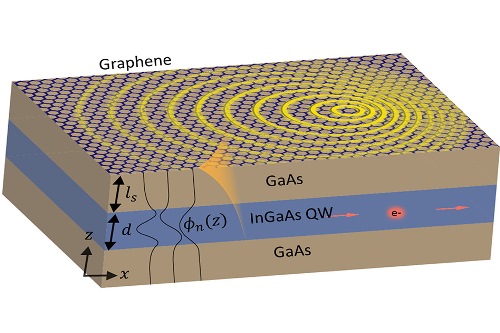Scientists have developed a new way of enhancing the interactions between light and matter, which could, in the future, lead to more efficient solar cells that collect a wider range of light wavelengths, and new kinds of lasers and light-emitting diodes (LEDs) that could have fully tuneable colour emissions.
The research, based on a theoretical study, was published on 4 June in Nature Photonics, and was carried out by researchers at the Massachusetts Institute of Technology (MIT) and the Israel Institute of Technology.
The fundamental principle behind the new approach is a way to get the momentum of photons to more closely match that of electrons, which is normally many orders of magnitude greater. Because of the huge disparity in momentum, these particles usually interact very weakly; bringing their momenta closer together enables much greater control over their interactions, which could enable new kinds of basic research on these processes as well as a host of new applications, the researchers say.

Researchers at MIT and Israel's Technion used a thin-film material composed of layers of gallium-arsenide and indium-gallium-arsenide, overlaid with a layer of graphene, as shown in this diagram, to produce strong interactions between light and particles that could someday enable highly tunable lasers or LEDs
According to Ido Kaminer, a professor of physics at Technion and former MIT postdoc, while silicon is a hugely important substance as the basis for most present-day electronics, it is not well-suited for applications that involve light, such as LEDs and solar cells — even though it is currently the principal material used for solar cells despite its low efficiency. Improving the interactions of light with an important electronics material such as silicon could be an important milestone toward integrating photonics — devices based on manipulation of light waves — with electronic semiconductor chips.
Most people looking into this problem have focused on the silicon itself, said Kaminer, but 'this approach is very different — we’re trying to change the light instead of changing the silicon.” Kurman adds that “people design the matter in light-matter interactions, but they don’t think about designing the light side.'
One way to do that is by slowing down, or shrinking, the light enough to drastically lower the momentum of its individual photons, to get them closer to that of the electrons. In their theoretical study, the researchers showed that light could be slowed by a factor of a thousand by passing it through a kind of multilayered thin-film material overlaid with a layer of graphene. The layered material, made of gallium arsenide and indium gallium arsenide layers, alters the behavior of photons passing through it in a highly controllable way. This enables the researchers to control the frequency of emissions from the material by as much as 20 to 30 per cent, commented lead author the Israel Institute of Technology.
The interaction of a photon with a pair of oppositely charged particles — such as an electron and its corresponding 'hole' — produces a quasiparticle called a plasmon, or a plasmon-polariton, which is a kind of oscillation that takes place in an exotic material such as the two-dimensional layered devices used in this research. Such materials 'support electromagnetic oscillations on its surface, really tightly confined' within the material, explained MIT graduate student Nicholas Rivera. This process effectively shrinks the wavelengths of light by orders of magnitude, he said, bringing it down 'almost to the atomic scale.'
Because of that shrinkage, the light can then be absorbed by the semiconductor, or emitted by it, he says. In the graphene-based material, these properties can actually be controlled directly by simply varying a voltage applied to the graphene layer. In that way, 'we can totally control the properties of the light, not just measure it,' noted Kurman.
Although the work is still at an early and theoretical stage, the researchers say that in principle this approach could lead to new kinds of solar cells capable of absorbing a wider range of light wavelengths, which would make the devices more efficient at converting sunlight to electricity. It could also lead to light-producing devices, such as lasers and LEDs, that could be tuned electronically to produce a wide range of colours. 'This has a measure of tunability that’s beyond what is currently available,' Kaminer said.
'The work is very general,' Kurman said, so the results should apply to many more cases than the specific ones used in this study. 'We could use several other semiconductor materials, and some other light-matter polaritons.' While this work was not done with silicon, it should be possible to apply the same principles to silicon-based devices, according to the researchers. 'By closing the momentum gap, we could introduce silicon into this world of plasmon-based devices', Kurman said.
Because the findings are so new, Rivera said, it 'should enable a lot of functionality we don’t even know about yet.'
Frank Koppens, a professor of physics at the the Institute of Photonic Sciences in Barcelona, who was not involved in this research, said that this work is 'highly significant, as it is a clear break with the conventional view on emitter-light interactions.' Since the work so far is theoretical, he said, 'the main question will be if this effect is visible in experiments.'
Koppens says that 'one can envision many applications, such as more efficient light emitters, solar cells, photodetectors etc. All integrated on a chip! It’s also a new way to control the colour of a light emitter, and I’m sure there will be applications that we didn’t even think of.'

